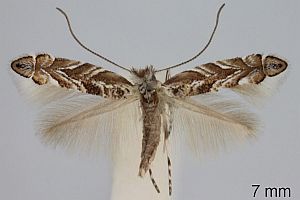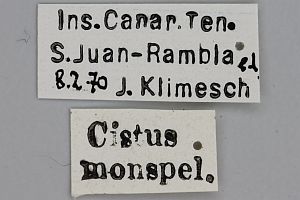

 +6Kontinente:EU
+6Kontinente:EU2. Diagnose
2.1. Geschlecht nicht bestimmt
3. Biologie
3.1. Nahrung der Raupe
- [Cistaceae:] Cistus salviifolius (Salbeiblättrige Zistrose)
- [Cistaceae:] Cistus monspeliensis (Montpellier-Zistrose)
- [Cistaceae:] Cistus incanus (Graubehaarte Zistrose)
In der Arbeit von Groschke (1944) werden auch schöne Details zur Biologie der Präimaginalstadien geschildert und eine Mine an Salbeiblättriger Zistrose skizziert. Das oben gezeigte Exemplar von Teneriffa aus der "Klimesch-Sammlung" wurde laut Etikett aus Montpellier-Zistrose gezüchtet. Nach der [Artseite auf gracillariidae.net] wurde diese Kombination schon unerkannt - weil fälschlicherweise Triberta helianthemella zugeordnet - in einem alten Aufsatz erwähnt: Walsingham, Lord (Thomas de Grey) 1908b. Microlepidoptera of Tenerife. - Proceedings of the Zoological Society of London 1907:911–1034, pls. 51–53. Konkret heißt es dort (S. 976): "Taken at Guimar: the larvae observed on Cistus monspeliensis." Die Graubehaarte Zistrose wurde durch Klimesch (1968) aus Mazedonien und dem angrenzenden Griechenland belegt.
4. Weitere Informationen
4.1. Andere Kombinationen
- Lithocolletis cistifoliella Groschke, 1944 [Originalkombination]
- Phyllonorycter cistifoliella (Groschke, 1944)
4.2. Typenmaterial
In der Erstbeschreibung durch Groschke (1944) ist zu erfahren: „Durch Zucht erhielt ich 8 Falter, die zwei verschiedenen Generationen angehören: 5 Tiere vom 4.XII.42 bis 9.I.43 und 3 Tiere vom 23.VI. bis 15.VII.43, außerdem fing ich einen frei fliegenden Falter am 2.IX.42, der wohl ein Nachzügler der Sommergeneration gewesen sein dürfte, am Monte Poretta bei Taormina. Am gleichen Ort fand ich auch die Raupen der gezüchteten Tiere“.
Diese Typenserie ist mit hoher Wahrscheinlichkeit komplett verloren gegangen. De Prins et al. (2013) legen daher einen Neotypus fest mit den Daten: "♂, [1] ‘Sicilia, Palermo, S. Martino d. Scale, 1–12.vi.1954, J. Klimesch’; [2] ‘genitalia slide TRB3554♂’, in the ZSM (Figs 10, 16). Additional specimen from the same series: ♀, ‘Sicilia, Mistretta, Mercuore, 700 m, 21–30.VI.52, J. Klimesch’, in the ZSM. Remarks: the abdomen of this female specimen is damaged and genitalia are not in condition to be examined."
Sie begründen die Notwendigkeit der Neotypen-Festlegung detalliert: "Neotype designation. The German lepidopterist Franz Groschke (1914–1956) worked at (or was associated with) the Zoological Institute in Tharandt (possibly part of the "Forstliche Hochschule Tharandt"), next to Dresden during the war years of his military service in 1940–1944. However his collection was not transferred to the State Museum of Zoology (Staatliches Museum für Tierkunde) in Dresden (Matthias Nuss, pers. corr.). The type specimens of Lithocolletis cistifoliella are also absent in Stuttgart (Staatliches Museum für Naturkunde Stuttgart) where Franz Groschke worked before his death in 1956 (Andreas Zwick, pers. corr.). There is no publication except the original description which refers to the type specimens of L. cistifoliella, though significant efforts were made to find them by Jozef Wilhelm Klimesch during the preparation of his study “Beiträge zur Kenntnis der Microlepidopteren-Fauna des Kanarischen Archipels” (1979). We believe that the type specimens of Lithocolletis cistifoliella Groschke 1944 were lost during the last years of the second world war or the years after the war, and could not be traced despite the efforts of the curators from Staatliches Museum für Tierkunde in Dresden and Staatliches Museum für Naturkunde in Stuttgart. There is an exceptional need to designate the name bearing type under the conditions specified by the ICZN Art. 75: (1) the neotype is designated with the express purpose to clarify the taxonomic status of closely related species within the new genus Triberta and to restore the species Lithocolletis cistifoliella Groschke 1944 from synonymy; (2) we present the diagnosis of the valid species L. cistifoliella and its bibliographic references; (3) label data are presented to ensure the recognition of the specimen designated; (4) we state that the neotype is consistent with what it is known of Lithocolletis cistifoliella Groschke, 1944 from the original description and the original illustrations (Groschke 1944: 122–124, figs. 7, 9); (5) the neotype originates near to the original type locality (ICZN Art. 76.1); (6) we designate as the neotype of Lithocolletis cistifoliella Groschke, 1944 the historic male specimen collected and studied by Josef Wilhelm Klimesch, who labelled it in the collection as ‘a paralectotypus’, but did not officially designate it as the neotype; (7) the deposition of the neotype is the ZSM, a publically recognized scientific institution, that has managed to preserve historic Lepidoptera specimens, has proper facilities for preserving this particular name-bearing type for CISTACEAE-FEEDING LITHOCOLLETINAE (GRACILLARIIDAE) Zootaxa 3741 (2) (8) 2013 Magnolia Press · 219 future generations, and assures the accessibility of the neotype of Lithocolletis cistifoliella Groschke, 1944 for further studies."
4.3. Taxonomie
De Prins et al. (2013) lösen das Taxon aufgrund morphologischer Unterschiede aus der Synonymie mit Triberta helianthemella und überführen beide Arten in die neue Gattung Triberta. Und Lopez-Vaamonde et al. (2021: 11) stellten beim Barcoding fest: "Interestingly, DNA barcodes distinguish clearly between species that had previously been synonymized [for instance, Par. alpicola (Wocke)/ Par. scoticella (Stainton); Ph. cerasicolella (Herrich-Schäffer)/ Ph. spinicolella (Zeller); Triberta cistifoliella (Groschke)/ T. helianthemella (Herrich-Schäffer)]. The validity ofall these species is considered confirmed here." Wir haben es hier also mit 2 klar getrennten Arten zu tun.
4.4. Faunistik
Barton (2018: 32) meldet de Art erstmals für Zypern: "Oreites Forest site A: 2.x.2014, specimen IB2123 and 3.x.2014, specimen IB2147; Nikokleia, 24.ix.2016, specimen IB2504, ♂, slide 975."
(Autor: Erwin Rennwald)
4.5. Literatur
- Baldizzone, G. & S. Scalercio (2018): Contributo allo conoscenza dei microlepidotteri dell'Aspromonte (Lepidoptera). — Bollettino della Società Entomologica Italiana 150 (2): 55–79. [PDF auf sei.pagepress.org]
- Barton, I. (2018): A second contribution to the Lepidopteran fauna of Cyprus, presenting new records for 48 taxa from 17 families. — The Entomologist’s Record and Journal of Variation 130: 29-39.
- Neotypus-Festlegung: De Prins, J., Davis, D. R., De Coninck, E., Sohn, J.-C. & P. Triberti (2013): Systematics, phylogeny and biology of a new genus of Lithocolletinae (Lepidoptera: Gracillariidae) associated with Cistaceae. — Zootaxa 3741 (2): 201-227 [PDF auf www.mapress.com].
- Erstbeschreibung: Groschke, F. (1944): Neues über Minierer aus dem Mittelmeergebiet. — Mitteilungen der Münchner Entomologischen Gesellschaft 34: 115-124 [hier 122-124] [Digitalisat auf www.archive.org].
- Klimesch, J. (1968): Die Lepidopterenfauna Mazedoniens, IV. Microlepidoptera: — 201 S. (Prirodonaucen muzej Skopje – posebno izdanie Nr.5), Skopje.
- Lopez-Vaamonde, C., Kirichenko, N., Cama, A., Doorenweerd, C., Godfray, H.C.J., Guiguet, A., Gomboc, S., Huemer, P., Landry, J.-F., Laštůvka, A., Laštůvka, Z., Lee, K.M., Lees, D.C., Mutanen, M., van Nieukerken, E.J., Segerer, A.H., Triberti, P., Wieser, C. & R. Rougerie (2021): Evaluating DNA Barcoding for Species Identification and Discovery in European Gracillariid Moths. — Frontiers in Ecology and Evolution, 9 (Artikel 626752): 1-16. [zum open-access-Artikel auf frontiersin.org]
- Walsingham, Lord (Thomas de Grey) (1908): Microlepidoptera of Tenerife. — Proceedings of the Zoological Society of London 1907: 911–1034, pls. 51–53. [Zugang über archive.org]










